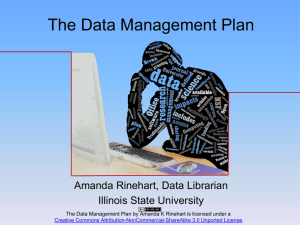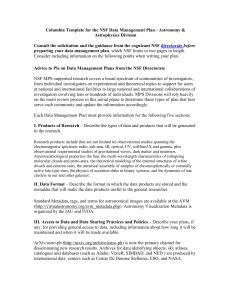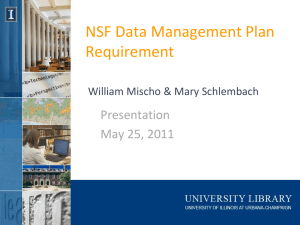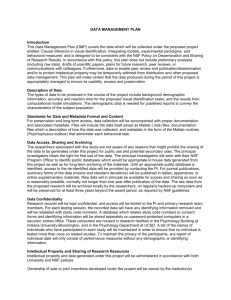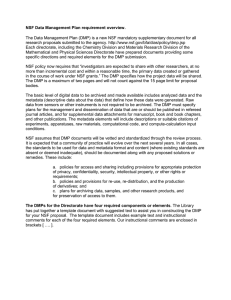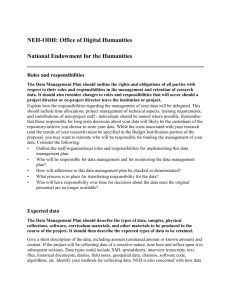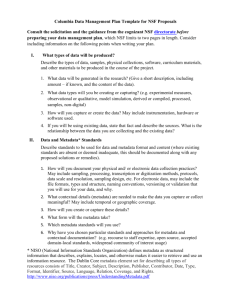NSF Data Management Plan Guide for Arctic Research
advertisement
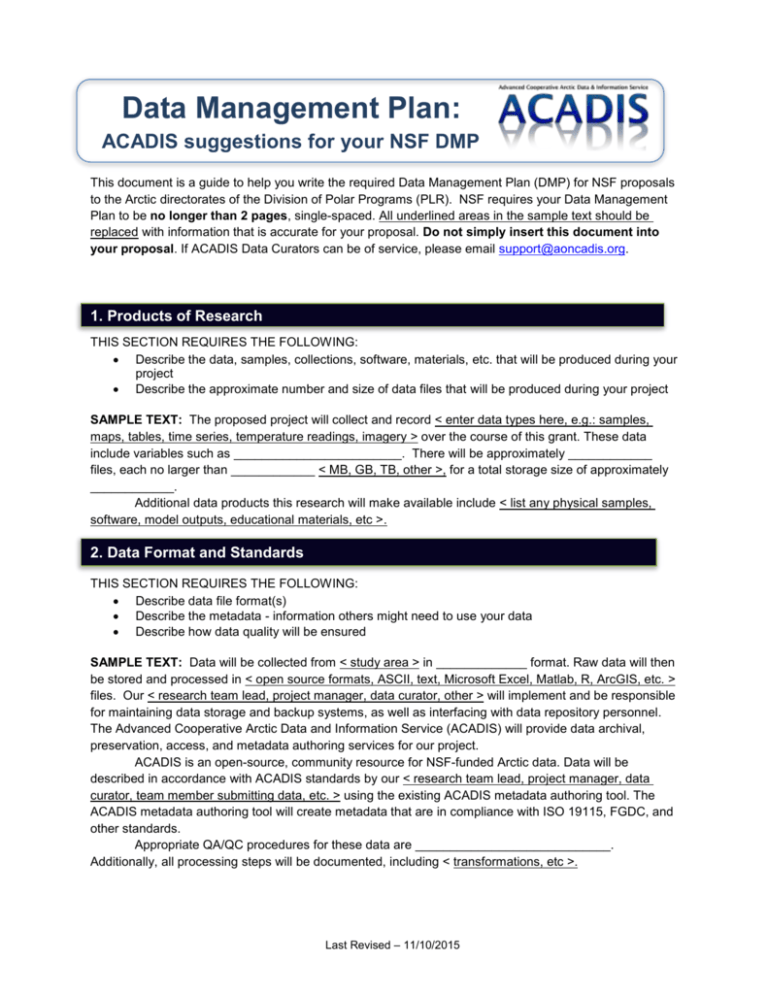
Data Management Plan: ACADIS suggestions for your NSF DMP This document is a guide to help you write the required Data Management Plan (DMP) for NSF proposals to the Arctic directorates of the Division of Polar Programs (PLR). NSF requires your Data Management Plan to be no longer than 2 pages, single-spaced. All underlined areas in the sample text should be replaced with information that is accurate for your proposal. Do not simply insert this document into your proposal. If ACADIS Data Curators can be of service, please email support@aoncadis.org. 1. Products of Research THIS SECTION REQUIRES THE FOLLOWING: Describe the data, samples, collections, software, materials, etc. that will be produced during your project Describe the approximate number and size of data files that will be produced during your project SAMPLE TEXT: The proposed project will collect and record < enter data types here, e.g.: samples, maps, tables, time series, temperature readings, imagery > over the course of this grant. These data include variables such as ________________________. There will be approximately ____________ files, each no larger than ____________ < MB, GB, TB, other >, for a total storage size of approximately ____________. Additional data products this research will make available include < list any physical samples, software, model outputs, educational materials, etc >. 2. Data Format and Standards THIS SECTION REQUIRES THE FOLLOWING: Describe data file format(s) Describe the metadata - information others might need to use your data Describe how data quality will be ensured SAMPLE TEXT: Data will be collected from < study area > in _____________ format. Raw data will then be stored and processed in < open source formats, ASCII, text, Microsoft Excel, Matlab, R, ArcGIS, etc. > files. Our < research team lead, project manager, data curator, other > will implement and be responsible for maintaining data storage and backup systems, as well as interfacing with data repository personnel. The Advanced Cooperative Arctic Data and Information Service (ACADIS) will provide data archival, preservation, access, and metadata authoring services for our project. ACADIS is an open-source, community resource for NSF-funded Arctic data. Data will be described in accordance with ACADIS standards by our < research team lead, project manager, data curator, team member submitting data, etc. > using the existing ACADIS metadata authoring tool. The ACADIS metadata authoring tool will create metadata that are in compliance with ISO 19115, FGDC, and other standards. Appropriate QA/QC procedures for these data are ____________________________. Additionally, all processing steps will be documented, including < transformations, etc >. Last Revised – 11/10/2015 3. Policies for Access and Sharing THIS SECTION REQUIRES THE FOLLOWING: How you will make your data and other products accessible? The approximate release date of data products Please be sure to check for specific release policies from the Directorate, Office, Division, Program, or other NSF unit to which you will be submitting. More information can be found at http://www.nsf.gov/geo/geo-data-policies/index.jsp SAMPLE TEXT: This project will upload data files and documentation to ACADIS < describe when data will be released e.g.: as soon as they have been quality controlled and processed, annually, upon completion of project (see NSF guidelines for time requirements) >. ACADIS publically releases data through their Gateway system immediately upon receipt. Data and data products will be made available with as few restrictions as possible. These data and metadata will be permanently archived and made freely available for access and use by all via web-based distribution through ACADIS. We < intend, do not intend > to impose a data embargo with the exception of _______________________ as approved by < the ARC Program Manager or other NSF unit >. We < expect, do not expect > that the data we generate will require special arrangements due to ethical restrictions or release of indigenous knowledge. There are < restrictions, no restrictions > on the use of data and products created by this project as long as the user includes a citation for the product. There are < privacy concerns, no privacy concerns > associated with the data. Existing data < will, will not > be required for our analysis. These data include ___________________________________ and will be obtained from < list website, researcher >. Relevant data will also be made available through these channels: ___________________. 4. Policies and Provisions for Re-use THIS SECTION REQUIRES THE FOLLOWING: Identify who will be most interested to use your data How will they be allowed to use your data? SAMPLE TEXT: Integration and re-use of the data relies on the data being well organized and adequately documented. The shared data are expected to be of interest to < list audience(s) >. It is possible that scientists from related disciplines may also use the data. To facilitate tracking of re-use and to give fair credit to the project and investigators, ACADIS can provide a recommended formal citation, including a persistent identifier or digital object identifier (DOI) for the submitted data set(s). 5. Archiving of Data THIS SECTION REQUIRES THE FOLLOWING: Will data be available after the funding for the project has ended? The long-term strategy for maintaining, curating, and archiving the data Description of necessary transformations to prepare data for preservation and data sharing SAMPLE TEXT: < Our data manager > will follow ACADIS guidelines to provide accurate and complete documentation for data preservation. ACADIS will ensure that the data are curated in a relevant long-term archive and ensure data will be available after project funding has ended. We will use ACADIS tools to create metadata for long-term data preservation. Data will be described in accordance with ACADIS standards. Last Revised – 11/10/2015
